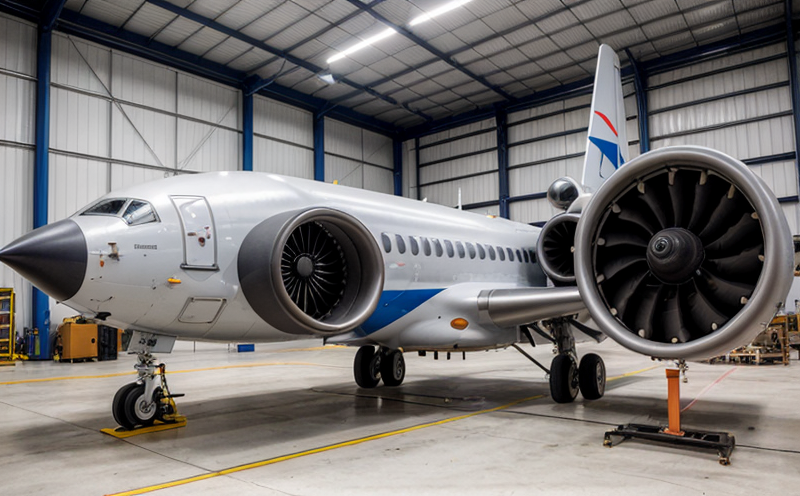Aircraft Fuselage Vibration Testing (MIL-STD-810)
The Aircraft Fuselage Vibration Testing per MIL-STD-810 is a critical process that ensures the structural integrity and operational reliability of aircraft fuselages. This standard is part of the broader Military Standard 810 series, which provides guidelines for environmental testing to ensure the survivability and performance of military equipment.
The primary objective of this test is to subject the fuselage specimen to a series of vibration levels that simulate the dynamic loads experienced during flight. This process helps identify potential weaknesses in design or manufacturing that could lead to failure under real-world conditions. The testing ensures compliance with stringent aerospace and defense requirements, thereby safeguarding aviation safety.
The MIL-STD-810 specifies a set of procedures for environmental testing, including vibration testing, which are designed to replicate the harsh operational environments faced by military aircraft. These tests help manufacturers validate that their products can withstand the rigors of actual use without compromising performance or reliability. The standard covers various aspects such as frequency ranges, amplitude levels, and duration of exposure.
During this test, a specimen fuselage is subjected to controlled vibration environments using shaker tables or vibration stands. The testing typically involves applying random vibrations across multiple axes (X, Y, Z) to simulate the dynamic loads encountered during flight maneuvers, turbulence, and other operational stresses. The frequency range for these tests can vary from low-frequency base excitation up to high-frequency excitations.
Preparation of the specimen is crucial before testing begins. This involves ensuring that all components are properly secured and assembled according to manufacturer specifications. Any loose parts or unsecured elements could introduce variability in test results, making it difficult to isolate the effects of vibration on the structure itself. Proper alignment of the specimen within the shaker table also ensures accurate measurement of strain and displacement.
Instrumentation plays a vital role in monitoring the performance of the specimen during testing. High-precision accelerometers are attached at strategic locations along the fuselage to capture data on acceleration, velocity, and displacement responses. Strain gauges may be used to measure localized stresses within critical areas such as joints or seams. These sensors provide real-time feedback that allows operators to adjust test parameters if necessary.
Once testing is complete, detailed reports are generated summarizing the results of each parameter measured during the trial. Compliance with MIL-STD-810 requirements is determined based on predefined acceptance criteria established by regulatory bodies like the Federal Aviation Administration (FAA) or equivalent international standards organizations.
- Benefits: Ensures structural integrity, enhances safety, improves durability, reduces maintenance costs, supports certification compliance.
- Industry Applications: Used in aerospace manufacturing for both commercial and military aircraft; essential for defense contractors bidding on government contracts.
Applied Standards
The Aircraft Fuselage Vibration Testing adheres to MIL-STD-810G, which is the latest revision of this military standard. This document encompasses a broad range of environmental stressors that can impact aircraft components, including mechanical shock, temperature cycling, humidity, salt fog exposure, and more.
Specifically relevant sections for vibration testing include Chapter 6 (Environmental Testing), Section 605 (Shock and Vibration). These sections outline the procedures and criteria used to conduct tests under controlled laboratory conditions. Compliance with these standards ensures that aircraft components are rigorously evaluated before entering service, reducing risks associated with operational failures.
Additionally, other relevant international standards such as AS9100D (Quality Management System for Aerospace) may be referenced during testing processes due to their alignment with best practices in manufacturing and quality assurance within the aviation industry. These standards emphasize continuous improvement, process control, and traceability throughout all stages of product development.
Benefits
- Ensures Structural Integrity: Identifies potential weaknesses in design or manufacturing that could lead to failure under real-world conditions.
- Enhances Safety: Provides assurance that the aircraft can safely operate even when exposed to extreme environmental stresses.
- Improves Durability: Helps manufacturers develop longer-lasting products by identifying areas susceptible to wear and tear early in the design process.
- Reduces Maintenance Costs: By finding issues early, ongoing maintenance expenses are minimized over the lifecycle of the aircraft.
- Supports Certification Compliance: Ensures that all tests meet regulatory requirements set forth by organizations like the FAA or EASA.
- Promotes Quality Assurance: Provides a systematic approach to quality control, ensuring consistent performance across multiple units produced.
Industry Applications
- Aerospace Manufacturing: Ensures that commercial and military aircraft meet strict reliability standards before entering service.
- Defense Contractors: Essential for companies bidding on government contracts, as it demonstrates capability to produce compliant products.
- Aviation Research & Development (R&D): Used by R&D teams to explore new materials or designs that can withstand harsh operational environments.
- Component Suppliers: Vital for suppliers who need to prove their parts are robust enough to endure the rigorous conditions of flight.





